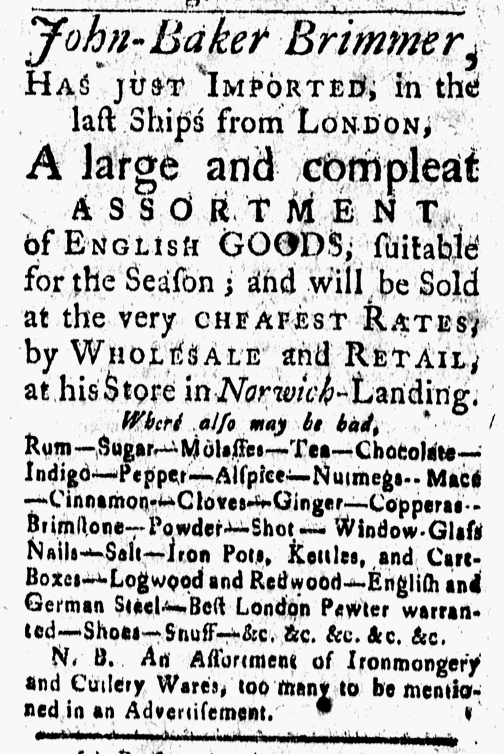What was advertised in a colonial American newspaper 250 years ago today?

“An Assortment of Ironmongery and Cutlery Wares, too many to be mentioned in an Advertisement.”
The New-London Gazette was a much smaller operation than the newspapers published in colonial America’s largest port cities in the late 1760s. It rarely published supplements, in part because the volume of advertising did not warrant doing so. In particular, its advertisements for consumer goods and services tended to be shorter and less elaborate than those inserted in many other cities. New London just was not as busy a port as others in the region, including Boston, Newport, New York, and Providence. The pages of the New-London Gazette reflected that; visually, most pages of that newspaper did not have the same bustling appearance as the crowded pages of publications from the larger ports.
Yet John-Baker Brimmer’s advertisement in the May 6, 1768, edition of the New-London Gazette looked as though it could have been drawn from a newspaper published in another city. In it, Brimmer made some of the standard appeals advanced in eighteenth-century advertisements, including an appeal to price (“the very CHEAPEST RATES”) and an appeal to consumer choice (“A large and compleat ASSORTMENT of ENGLISH GOODS”). He underscored the wide selection prospective customers would encounter at his shop by listing more than two dozen items from among his merchandise, everything from rum and spices to shoes and snuff. He even concluded his list with “&c. &c. &c. &c. &c.” In repeating the eighteenth-century abbreviation for et cetera so many times, he proclaimed that he had a much more extensive inventory than space permitted him to include in his notice. He made the same point in a nota bene that concluded the advertisement: “An Assortment of Ironmongery and Cutlery Wares, too many to be mentioned in an Advertisement.” Merchants and shopkeepers who advertised in newspapers published in other cities sometimes resorted to this strategy, leaving it to readers’ imaginations to envision all sorts of wares available for purchase in their shops.
When it came to marketing consumer goods and services, advertising culture was not as developed in the New-London Gazette as in other newspapers, yet some advertisers, like Brimmer, adopted many of the same methods as their counterparts in larger cities. Brimmer amalgamated basic appeals to price and choice with several means of suggesting that he did indeed stock an array of goods, including a list, claims that his inventory was too extensive to describe in greater detail, and repeated use of “&c.” Such advertisements in smaller newspapers helped to fuel the consumer revolution far beyond colonial America’s major urban ports.
